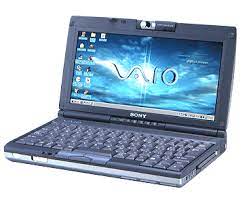Posted on July 3, 2021
Sony Vaio PictureBook PCG-C1VE
Building ultra mobile computers always pushed the limits. With the PictureBook, Sony set the stage, with a unique and advanced design, standing out of the grey and boring world of the time.
Quick Links:
Historic Overview
It’s the year 1998. Not too long ago, there existed only grey and uniform computers. Built for the purpose, function follows technology. That was also true for Notebooks, being mostly clunky and monotone in color and design. This was slowly to change when Apple hit the Market with their colorful translucent G3 iMac lineup. Sony then set the stage in a similar way, with their unique VAIO brand appearance and the PictureBook series.

Being in the market initially only in Japan, the PictureBook eventually also made it’s appereance in the European and US markets in around 2000.
As it was typical for the time, delivering decent computing performance on portable devices was near to impossible to accomplish without sacrificing battery running time.
Hence no wonder we’d see only low rated CPUs in the beginning: The first PictureBook featured a 233 MHz-rated Pentium MMX. Later, 400 MHz rated Pentium II and higher clocked Transmeta Crusoe CPUs became available during 2000, though addmittedly not meeting up top-performance needs, whereas contemporary desktop PCs where already scratching at or exceeding the 1 GHz barrier at the time.
As noted in the U series, Sony was to introduce the Transmeta Crusoe CPU for the ultra mobiles, and we saw that CPU propably the first time ever in the PictureBook series during the second half of 2000. Trading power efficiency and battery running time against the rather low performance of the Transmeta CPU, owed to the code morphing technology and the overhead it brought along, was something these little beauties suffered from.
I actually owned one of these myself back in the days, unfortunately selling it off during the mid 2000s, something I deeply regret today. I later reacquired a french version of the PCG-C1VE, which fortunately came with all accessories. The only drawback is the display, which luckily works, but the outher display protective layer is totally borked and thus needs replacement.
Specs
The PHINTAGE Collection currently holds a Sony Vaio PictureBook.
| Vendor | Sony |
| Model | Vaio PictureBook PCG-C1VE |
| Released | 2000 |
| Original Streetprice | <TBD> |
| Weight | 1 KG |
| Dimensions | 24 cm x 15 cm x 2.8 cm |
| Builtin Display | Yes, 8.6″ UXGA (1600×1200) display |
| Builtin Battery | Yes, <TBD> |
| CPU | Transmeta Crusoe TM5600 600 MHz |
| RAM | 128 MiB |
| Storage | 12 GiB ATA 2.5 Harddrive Memory Stick slot |
| Network Support |
|
| USB | 1 USB 1.1 |
| Video Output | |
| Other | 1 x modem – phone line – RJ-11 1 x display / video – VGA – 15 pin HD D-Sub (HD-15) 1 x USB 4 pin USB Type A 1 x microphone – input – mini-phone mono 3.5 mm 1 x IEEE 1394 (FireWire) 6 pin FireWire 1 x audio – line-in – mini-phone stereo 3.5 mm 1 x headphones – output – mini-phone stereo 3.5 mm 1 x display / video – composite video/audio output |
| Operating System | Microsoft Windows XP |
| Overall Condition |
|
| Restoration Parts needed |
|
| Benchmark Results | SiSoft Sandra 99, CPU benchmark: CPU Dhrystone: 1090 MIPS CPU Whetstone: 396 MFLOPS SiSoft Sandra 99, Multimedia benchmark: Integer ALU: 505 it/s Floating Point FPU: 259 it/s Norton Utilities 3.1: Computing Index, relative to IBM/PC: N/A Norton Utilities 4.5: Computing Index, relative to IBM/XT: 853.7 Norton Utilies 8.0: CPU Speed: 456.4 |
Gallery
Coming soon.
